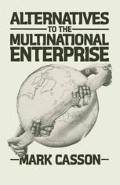Abstract
This chapter considers the extent to which the competitiveness and profitability of the MNE stem from its ability to enhance the efficiency of world-wide resource allocation. It is argued that the advantage of the MNE is based on its facility for transferring resources internationally without exchange of ownership.1
Access this chapter
Tax calculation will be finalised at checkout
Purchases are for personal use only
Preview
Unable to display preview. Download preview PDF.
3. The Rationale of the Multinational Enterprise
The analysis in this chapter is an extension of the theory presented in P. J. Buckley and M. C. Casson, The Future of the Multinational Enterprise, London, 1976.
The seminal work is R. H. Coase, ‘The nature of the firm’, Economica N. S., 4 (1937), pp. 386–405.
Other influential writings include A. A. Alchian and H. Demsetz, ‘Production, information costs and economic organisation’, American Economic Review, 62 (1972), 777–95;
K. J. Arrow, ‘The organisation of economic activity’, in ‘The analysis and evaluation of public expenditure: The PPB system’, Joint Economic Committee, 91st Congress, 1st Session, 1969, pp. 59–75;
K. J. Arrow, ‘Vertical integration and communication’, Bell Journal of Economics, 5 (1975), pp. 173–83;
B. J. Loasby, Choice, Complexity and Ignorance, Cambridge, 1975;
H. Malmgren, ‘Information, expectations and the theory of the firm’, Quarterly Journal of Economics, 75 (1961), pp. 399–421;
J. C. McManus, ‘The theory of the multinational firm’, in G. Paquet (ed.), The Multinational Firm and the Nation State, Toronto, 1972;
E. T. Penrose, The Theory of the Growth of the Firm, Oxford, 1959;
G. B. Richardson, Information and Investment, London, 1960;
E. A. G. Robinson, The Structure of Competitive Industry, London, 1932;
F. M. Scherer et al., The Economics of Multi-Plant Operation, Harvard, 1975
G. J. Stigler, The Organisation of Industry, Homewood, Illinois, 1968, and
O. E. Williamson, Markets and Heirarchies, New York, 1975.
For a review of alternative theories of the MNE see J. H. Dunning, ‘The determinants of international production’, Oxford Economic Papers, 25 (1973), pp. 289–336, and the same author’s ‘Trade, location Of economic activity and the MNE: A search for an eclectic approach’, in B. Ohlin, P-O. Hesselborn and P. M. Wijkman (eds.), The International Allocation of Economic Activity, London, 1977.
Interesting approaches to the theory of the MNE have been developed in A. Erdilek, ‘Can the multinational corporation be incorporated into the general equilibrium theory of international trade and investment?’ presented at the Western Economic Association, Las Vegas, 1974;
T. Horst, ‘Theory of the multinational firm’, Journal of Political Economy, 79 (1971), pp. 1059–72;
T. Horst, ‘The theory of the firm’, in J. H. Dunning (ed.), Economic Analysis and the Multinational Enterprise, London, 1974, and
S. P. Magee, ‘Multinational corporations, industry technology cycle and development’, Journal of World Trade Law 11 (1977), pp. 297–321.
Most of the literature on the subject of price versus non-price market-clearing is to be found in the theory of planning. See G. M. Heal, ‘Planning without prices’, Review of Economic Studies, 36 (1969), pp. 347–62, and
J. M. Montias, The Structure of Economic Systems, New Haven, 1976.
For a comparison of negotiations and arbitration see W. Hildenbrand and A. P. Kirman, Introduction to Equilibrium Analysis, Amsterdam, 1976.
For a more detailed study of negotiations see I. Stahl, Bargaining Theory, Stockholm, 1972 and
L. G. Telser, Competition, Collusion and Game Theory, London, 1971.
The ‘free rider’ problem is discussed in N. M. Singer, Public Microeconomics, Boston, 1972, Chapter 6.
Cf. S. N. S. Cheung, ‘Transaction costs, risk aversion and the choice of contractual arrangements’, Journal of Law and Economics 12 (1969), pp. 23–42;
H. Demsetz, ‘The exchange and enforcement of property rights’, Journal of Law and Economics 7 (1964), pp. 11–26, and
H. Demsetz, ‘The cost of transacting’, Quarterly Journal of Economics 82 (1968), pp. 33–53.
There is an extensive recent literature on property rights. For a general survey see E. G. Furubotn and S. Pejovich (eds.), The Economics of Property Rights, Cambridge, Mass., 1974, and in particular
see S. Pejovich, ‘Towards an economic theory of the creation and specification of property rights’, Review of Social Economy, 1972, pp. 309–25.
These are examples of ‘transfer pricing’; see L. V. Niekels, Transfer Pricing in Multinational Firms, Stockholm, 1976.
The wider consequences of transfer pricing are examined in S. Lall, ‘Transfer-pricing by multinational manufacturing firms’, Oxford Bulletin of Economics and Statistics, 35 (1973), pp. 173–95, and
D. Macaluso and R. G. Hawkins, ‘The avoidance of restrictive monetary policies in host countries by multinational firms’, University of Reading Discussion Papers in International Investment and Business Studies, No. 25, 1976.
The problem of monitoring the quality of managerial services arises from the conflict of interests between management and shareholders. It is extensively discussed in R. L. Marris, The Economic Theory of Managerial Capitalism, London, 1964 and
O. E. Williamson, The Economics of Discretionary Behaviour, Englewood Cliffs, New Jersey, 1964.
Copyright information
© 1979 Mark Casson
About this chapter
Cite this chapter
Casson, M. (1979). The rationale of the multinational enterprise. In: Alternatives to the Multinational Enterprise. Palgrave Macmillan, London. https://doi.org/10.1007/978-1-349-04645-4_3
Download citation
DOI: https://doi.org/10.1007/978-1-349-04645-4_3
Publisher Name: Palgrave Macmillan, London
Print ISBN: 978-1-349-04647-8
Online ISBN: 978-1-349-04645-4
eBook Packages: Palgrave Business & Management CollectionBusiness and Management (R0)

